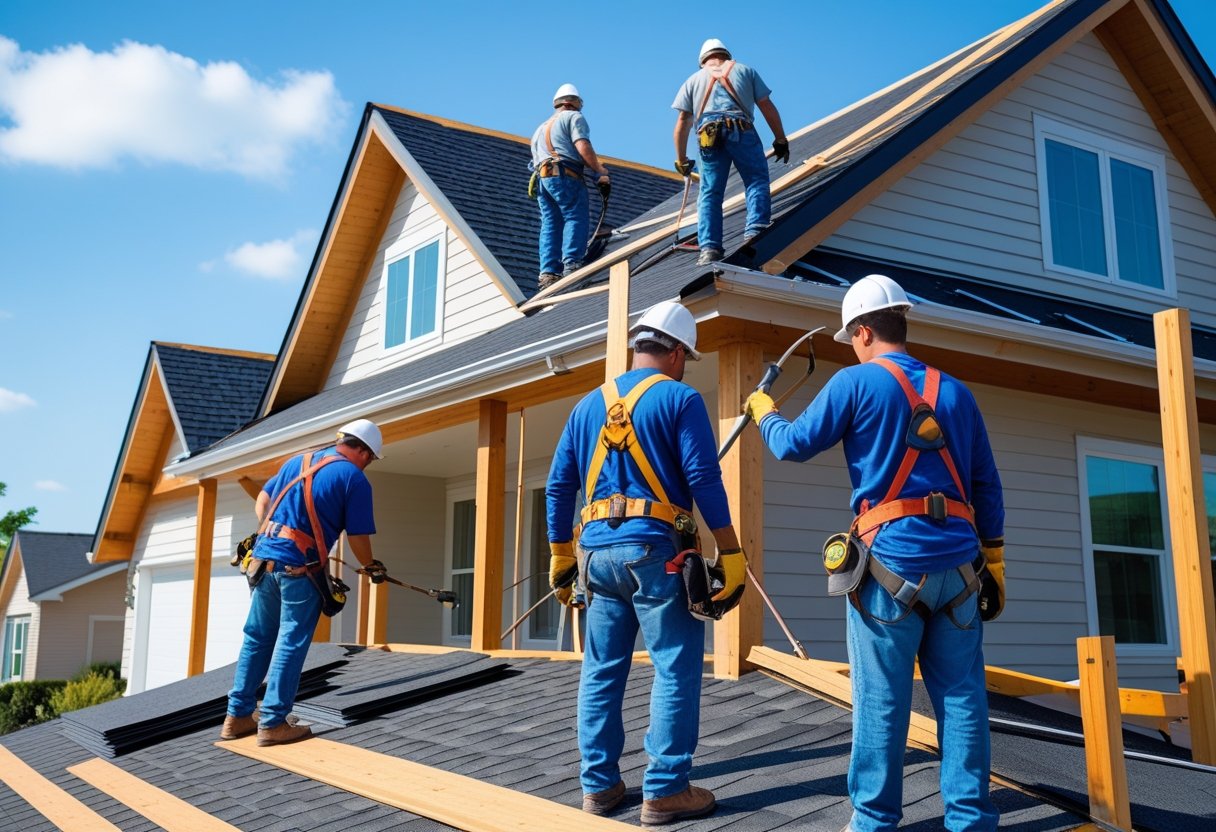Estimating the cost to replace your roof doesn’t have to be confusing or time-consuming. You can get a good idea of the price by looking at your roof’s size and the type of materials you want to use.
For example, a typical roof around 2,200 square feet can cost between $11,000 and $22,000, depending on materials and labor.
Knowing how to estimate your roof replacement cost helps you plan your budget and avoid surprises when you get quotes from professionals. It also gives you confidence to ask the right questions and understand what you’re paying for.
This guide will show you simple steps to figure out your roof’s estimate on your own. You’ll be able to make smart choices for your home.
Understanding Roof Replacement Costs
Knowing what makes roof replacement prices go up or down helps you estimate your own costs better. You need to look at what affects the price, the usual material costs, and what extra fees might surprise you.
Key Factors That Affect Pricing
Several things can change the price of your roof replacement. First, the size of your roof matters—a bigger roof means more materials and labor.
Material type is another big driver. Asphalt shingles cost less, while metal or tile roofs cost more.
Labor costs depend on where you live and how easy it is to access your roof. If your roof has a steep slope or unusual shape, this adds to the cost.
If your roof has hidden damage or needs structural fixes, expect higher prices.
Average Cost Ranges by Roof Type
Different materials have different price ranges. Here’s a quick look at common roofing materials and their estimated ranges for a typical 2,000 square foot home:
MaterialAverage Cost Range Asphalt Shingles$8,900 – $15,000Metal Roof$15,000 – $30,000Tile or Slate$25,000 – $50,000+
These prices include materials and labor but can change based on your area and project details.
Hidden Expenses to Watch For
Some hidden costs can surprise you. For example, removal and disposal of old roofing material can add several hundred to a few thousand dollars.
You might also need permits from your city, which have fees. Sometimes, additional repairs like fixing rotten wood or adding insulation come up once work begins.
Don’t forget about roof inspections, which usually cost $75 to $400. These inspections are important before and after replacement to catch problems early.
Preparing To Estimate Your Roof Replacement
Before you start estimating your roof replacement cost, you need to collect the right tools, check your roof’s condition, and measure its size. These steps give you a clearer picture of what to expect and help you plan better.
Gathering Tools and Materials
To estimate your roof replacement, you’ll need a few basic tools. Start with a tape measure, ladder, camera or smartphone, safety gear, and a notebook or app to record details.
Make sure your ladder is stable and tall enough to reach your roof safely. Wear gloves and non-slip shoes for protection.
You might want a roofing calculator or spreadsheet to track measurements and costs. Having these materials ready makes your job easier and more accurate.
Inspecting Roof Condition
Look closely at your roof to spot any damage or wear. Check for missing or cracked shingles, broken flashing, or signs of leaks inside your attic.
Raise your ladder carefully to see the roof surface. Take photos of problem areas to compare later.
Knowing your roof’s condition helps you decide if you need a full replacement or simple repairs. This will affect your estimated cost.
Measuring Your Roof Surface Area
The size of your roof is key to finding the replacement cost. Measure the length and width of each section of your roof.
Multiply length by width to get the area for each part, then add them together. If your roof has slopes, multiply the total area by a slope factor (usually about 1.1 to 1.3).
For example:
Roof SectionLength (ft)Width (ft)Area (sq ft) Front4020800Side3025750Total Area1,550
This total gives you a base for estimating materials and labor costs.
Calculating Material Costs
To figure out how much your roof replacement materials will cost, you need to pick the right material, estimate how much you’ll need, and find local prices.
Choosing the Right Roofing Material
The type of material you choose affects both price and durability. Common options include asphalt shingles, metal, tile, and wood shakes.
Asphalt shingles are usually the cheapest and easy to install. Metal roofs cost more but last longer and can save on energy bills.
Tile and wood usually require more care and installation time, which adds to the price. Think about your climate, how long you want the roof to last, and your budget.
Check if local building codes or homeowner rules limit material choices.
Estimating Material Quantity
First, measure the square footage of your roof. Multiply the length by the width of each roof section and add those together.
Roofing material is sold in “squares,” where 1 square equals 100 square feet. Add about 10% extra for waste and cuts during installation.
For example, if your roof is 1,200 square feet, you’ll need roughly 13 squares of material (12 squares + 10% waste). Don’t forget extra materials like underlayment, nails, flashing, and drip edges.
Checking Local Material Prices
Material prices vary by location and supplier. Call local roofing supply stores or check online to get current prices for your chosen materials.
Prices will also change depending on the brand or grade. Labor and delivery costs might not be included in the material price, so ask about those.
Getting multiple quotes helps you find the best price. Keep a list of prices to compare so you can plan your budget accurately.
Labor and Installation Expenses
When figuring out the cost of your roof replacement, labor and installation charges make up a big part of the total price. These costs depend on how many hours the work takes and what makes your project harder or easier.
Estimating Labor Hours
Labor hours are how long it takes workers to remove your old roof and put on the new one. On average, it can take one to three days for a typical roof.
For a simple roof on a small home, it might only take a day or less. Bigger homes or complex roofs with many angles and layers will need more time.
Weather and crew size play a role. If workers face rain or heat, they may work slower, increasing hours.
More workers can speed things up but might cost more overall. You can estimate labor hours by noting your home’s size and roof style, then checking online for local crew speeds or asking local roofing companies for rough estimates.
Factors That Influence Labor Pricing
Labor pricing varies by your location and how hard the installation is. In cities like Austin, costs might be higher due to demand and wages.
Labor rates usually include the workers’ pay, taxes, insurance, and company overhead. If your roof needs extra care—like removing many layers, dealing with steep slopes, or fixing damage under the shingles—expect more labor costs.
Special materials or complex designs make the job tougher and pricier. Choosing a trusted company ensures the job is done right, even if labor costs seem higher.
A quality installation saves you money long-term by preventing future problems.
Additional Roof Replacement Expenses
When estimating the total cost of replacing your roof, some extra charges can add up beyond materials and labor. These costs often include disposal fees for old roofing materials and legal fees like permits and inspections.
Disposal and Cleanup Fees
After your old roof is removed, you need to dispose of the waste. This can include shingles, nails, and other debris.
You’ll likely pay a fee to haul and dump this at a landfill or recycling center. Disposal costs can range from $300 to $1,000 depending on your roof size and local landfill rates.
Cleanup is important and often included in labor, but you should ask your contractor if it’s billed separately. If your roof has multiple layers or hazardous materials like asbestos, disposal fees can be higher.
Make sure your quote clearly states how waste removal is handled.
Permit and Inspection Costs
Most cities or counties require permits before you start your roof replacement. Permits ensure the job follows local building codes and safety rules.
Costs for permits usually range between $150 and $500, but can vary by area. After the work, you may need an inspection done by a local official.
This is often required to approve your new roof and ensure it meets regulations. Skipping permits can cause fines or problems if you sell your home later.
Always check with your contractor if permit fees are included in your estimate or if they’ll be extra. It’s better to plan for this cost upfront.
Creating Your Roof Replacement Cost Estimate
To figure out your roof replacement cost, you need to add up all the project expenses and set aside extra money for surprises.
Adding Up All Project Expenses
Start by measuring your roof’s total area in square feet. Most roofing materials are priced per square, which is 100 square feet.
Multiply your roof area by the cost per square for the materials you want, such as asphalt shingles or metal panels. Next, include labor costs.
Labor can be about 40% to 60% of the total job price and depends on roof complexity and local rates. Don’t forget extras like permits, disposal fees, and new underlayment.
Use a simple list like this to track expenses:
- Roof size and material cost
- Labor fees
- Permit and disposal fees
- Underlayment and flashing
- Additional repairs (if needed)
This way, you can see where your money goes and avoid surprises.
Accounting for Contingencies
Always plan for unexpected costs. Roofs can reveal hidden damage like rotting wood or leaks once old shingles are removed.
Setting aside about 10% to 15% of your estimated budget helps cover these extras. Weather delays or changes in material prices can also increase costs.
By having contingency money ready, you can handle emergencies or unexpected work without needing new approvals or loans. This safety net protects your plan and keeps your project running smoothly.
Tips to Save on Roof Replacement
Start by getting multiple quotes from trusted local roofers. This helps you compare prices and find the best deal.
Make sure each quote includes labor, materials, and any extra fees.
Look for simple roofing materials that still offer good protection. Some materials cost less but work well for your home.
Avoid the most expensive options if your budget is tight.
Set aside an extra 10-15% for surprises. Small repairs under the roof deck or other hidden issues can add up.
Planning for surprises helps you avoid stress later on.
You can save by doing some prep work yourself, like clearing the roof area or moving outdoor furniture. This cuts down on labor time and costs.
Work with a local company that understands your climate and building codes. Local experts can suggest the best materials and methods, helping you avoid costly mistakes.
Ask your roofer about warranty details. A good warranty covers future repairs and protects your investment.
TipWhy It Helps Get multiple quotesFind competitive pricesChoose simple materialsLower material costsBudget for surprisesAvoid unexpected expensesPrep site yourselfReduce labor costsUse local expertsRight materials for your areaCheck warrantiesProtect long-term investment
When To Consult a Roofing Professional
Talk to a roofing professional if your roof shows signs of serious damage like leaks, missing shingles, or sagging. These problems can be tricky to assess on your own and might need expert attention.
If your roof is older, a pro can tell you if it’s better to repair or replace it. Age and wear affect cost and safety.
Getting a professional opinion helps you avoid spending too much on repairs that don’t last.
A roofer can check local factors like weather, building codes, and materials that affect cost. They also know the best quality options for your area.
When you consult a professional, they can provide a detailed estimate including:
Cost ElementWhat It Includes LaborSkilled workers and time on siteMaterialsShingles, underlayment, nailsAdditional ServicesInspections, permits, cleanup
You might want help with insurance claims. Many roofers assist with paperwork and talk to insurers to make the process easier for you.
If you live in Austin or nearby, Clear Choice Roofing is a good option. They offer free estimates and are known for honest service and quality work.
Calling a trusted company means you get clear advice that fits your needs.
Frequently Asked Questions
Knowing how to figure out your roof replacement cost depends on measuring your roof size, choosing materials, and understanding local price differences.
Each part affects the total price in different ways.
What are the steps to calculate the cost of replacing a roof by myself?
First, measure your roof’s total area in square feet. Then, find out the cost per square foot for your chosen roofing material.
Multiply the area by the cost per square foot. Add extra costs for removal, labor, and permits.
Can you provide a ballpark figure for the cost to re-roof a typical suburban home?
You can expect to pay between $3 and $10 per square foot on average. A typical home may fall around 1,500 to 2,000 square feet in roof area.
Prices usually range from $4,500 to $20,000 depending on materials and job complexity.
What factors influence the cost of a new roof for different sized homes?
The size of your roof, the material you pick, pitch or steepness of your roof, and how easy or hard it is to work on all impact costs.
Larger roofs generally mean more material and labor, which raises the total price.
Is there an easy-to-use calculator for estimating roofing costs?
Yes, many websites offer roofing cost calculators where you enter your roof measurements and material choice.
These tools give quick estimates that can help you plan your budget.
How does regional location, like Alabama, affect the overall roofing replacement expenses?
Labor rates and material costs vary by region. In places like Alabama, prices might be lower or higher depending on the local market and climate needs, such as extra weatherproofing against humidity or storms.
Are there any DIY tips for accurately measuring my home's roof area for replacement cost estimation?
Use a tape measure to find the length and width of your house’s outer walls. Multiply these numbers for each section of your roof.
Add 10-15% extra to your total measurement to account for overlaps and slopes. This helps ensure you have enough material.



